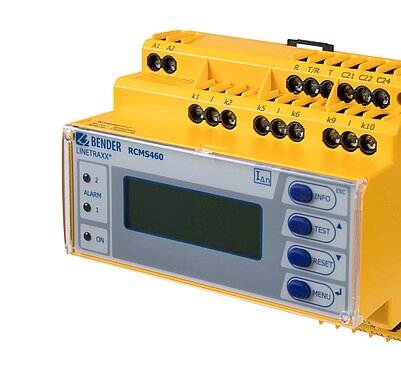

Pipelines are used for oil and gas transport across long distances, and electrical safety in oil and gas transport is essential. Pipe heating systems and other heating systems are also required in the process. These are monitored by type “B” Bender fault current systems. Any faults are reported immediately before a system shutdown becomes necessary.
In a compressor or condenser station, a compressor compresses the natural gas to compensate for pressure losses. Natural gas is stored at high pressure, and the pressure in the pipeline falls because of flow losses. A driving machine drives the compressor at up to 30 MW. These drive machines can be either gas turbines or gearless electric motors. For electric motors, frequency converters are required, which need to be monitored for their insulation levels or existing leak currents.
To cover relatively large distances, there are pump stations to pump the oil or gas. Since the pressure to transport raw material is reduced due to flow losses, the pump stations aim to increase pressure again. Gearless electric motors power the pump. This means frequency converters are required, which need to be monitored for their insulation level or any fault current present.
A tanker transports liquids or gaseous materials such as crude oil, oil as a finished product, fuel, or liquid gas. Tankers have pumps for unloading and pumping around the load on board. These pumps are powered by gearless electric motors for which frequency converters are required to monitor insulation levels or existing fault currents. One of the critical components of shipping engineering is the main machine with its auxiliary generators, kettle systems, auxiliary diesel, and generators for power generation and loading pumps. The main distribution board on-board the tankers are generally designed as ungrounded systems monitored with ISOMETER®s and fault locators.
| Name | Category | Size | Language | Timestamp | D-/B-Number |
|---|---|---|---|---|---|
| Product Overview - Residual Current Monitoring | Product Overviews | 8.0 MB | EN | 2025/04/0202.04.2025 | |
| 2020 Guidelines (US) | Technical Information | 1.9 MB | EN | 2020/06/1515.06.2020 | |
| Overview Brochure | Product Overviews | 10.3 MB | EN | 2023/10/0202.10.2023 | |
| Bender Industry Applications | Market Segment Brochures | 5.9 MB | EN | 2024/09/0404.09.2024 |
Products

Multi-channel AC/DC ground-fault monitor

Multi-channel AC/DC ground-fault monitor with individual relay outputs

AC/DC ground-fault monitor
![[Translate to North American English:] RCMA423](/fileadmin/_processed_/a/d/csm_RCMA423_01_WEB_2dc3226c4f.jpg)
AC/DC ground-fault monitor
![[Translate to Canadian English:] LINETRAXX® CTUB100 Series](/fileadmin/_processed_/0/d/csm_CTUB10x-CTBCx_WEB_SI_d8b0d156d2.jpg)
AC/DC sensitive measuring current transformer (Type B)
![[Translate to North American English:] NGRM700](/fileadmin/_processed_/3/b/csm_NGRM700_01_WEB_list_97278228d7.jpg)
Monitor for use in high-resistance grounded systems

Multi-channel AC/DC ground-fault monitor

Multi-channel AC/DC ground-fault monitor with individual relay outputs

AC/DC ground-fault monitor
![[Translate to North American English:] RCMA423](/fileadmin/_processed_/a/d/csm_RCMA423_01_WEB_2dc3226c4f.jpg)
AC/DC ground-fault monitor
![[Translate to Canadian English:] LINETRAXX® CTUB100 Series](/fileadmin/_processed_/0/d/csm_CTUB10x-CTBCx_WEB_SI_d8b0d156d2.jpg)
AC/DC sensitive measuring current transformer (Type B)
![[Translate to North American English:] NGRM700](/fileadmin/_processed_/3/b/csm_NGRM700_01_WEB_list_97278228d7.jpg)
Monitor for use in high-resistance grounded systems
Elektrische Sicherheit in Niederspannungsnetzen bis AC 1 000 V und DC 1 500 V – Geräte zum Prüfen, Messen oder Überwachen von Schutzmaßnahmen - Teil 9: Einrichtungen zur Isolationsfehlersuche in IT-Systemen
Elektrische Sicherheit in Niederspannungsnetzen bis AC 1 000 V und DC 1 500 V – Geräte zum Prüfen, Messen oder Überwachen von Schutzmaßnahmen - Teil 8: Isolationsüberwachungsgeräte für IT-Systeme
Elektrische Sicherheit in Niederspannungsnetzen bis 1000 V AC und 1500 V DC - Geräte zum Prüfen, Messen oder Steuern von Schutzsystemen - Teil 15: Anforderungen an die funktionale Sicherheit von Isolationssteuergeräten in IT-Systemen und Geräten zur Erkennung von Isolationsfehlern in IT-Systemen
Ausrüstung von Starkstromanlagen mit elektronischen Betriebsmitteln